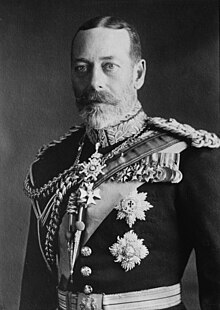
Back George V van die Verenigde Koninkryk Afrikaans Chorche V d'o Reino Uniu AN Georgius V Bretta Cyning ANG جورج الخامس ملك المملكة المتحدة Arabic جورج الخامس ملك المملكه المتحده ARZ Xurde V del Reinu Xuníu AST V Corc Azerbaijani بئشینجی جوْرج AZB George V saking Britania Raya BAN George V. von Großbritannien BAR
| George V | |||||
|---|---|---|---|---|---|
 Formal portrait, 1923 | |||||
| Reign | 6 May 1910 – 20 January 1936 | ||||
| Coronation | 22 June 1911 | ||||
| Imperial Durbar | 12 December 1911 | ||||
| Predecessor | Edward VII | ||||
| Successor | Edward VIII | ||||
| Born | Prince George of Wales 3 June 1865 Marlborough House, Westminster, Middlesex, England | ||||
| Died | 20 January 1936 (aged 70) Sandringham House, Norfolk, England | ||||
| Burial | 28 January 1936 Royal Vault, St George's Chapel, Windsor Castle 27 February 1939North Nave Aisle, St George's Chapel | ||||
| Spouse | |||||
| Issue Detail | |||||
| |||||
| House |
| ||||
| Father | Edward VII | ||||
| Mother | Alexandra of Denmark | ||||
| Religion | Protestant | ||||
| Signature | |||||
| Military career | |||||
| Service | Royal Navy | ||||
| Years of active service | 1877–1892 | ||||
| Rank | Full list | ||||
| Commands | |||||
George V (George Frederick Ernest Albert; 3 June 1865 – 20 January 1936) was King of the United Kingdom and the British Dominions, and Emperor of India, from 6 May 1910 until his death in 1936.
George was born during the reign of his paternal grandmother, Queen Victoria, as the second son of the Prince and Princess of Wales (later King Edward VII and Queen Alexandra). He was third in the line of succession to the British throne behind his father and his elder brother, Prince Albert Victor. From 1877 to 1892, George served in the Royal Navy, until his elder brother's unexpected death in January 1892 put him directly in line for the throne. The next year George married his brother's former fiancée, Princess Victoria Mary of Teck, and they had six children. When Queen Victoria died in 1901, George's father ascended the throne as Edward VII, and George was created Prince of Wales. He became king-emperor on his father's death in 1910.
George's reign saw the rise of socialism, communism, fascism, Irish republicanism, and the Indian independence movement, all of which radically changed the political landscape of the British Empire, which itself reached its territorial peak by the beginning of the 1920s. The Parliament Act 1911 established the supremacy of the elected British House of Commons over the unelected House of Lords. As a result of the First World War (1914–1918), the empires of his first cousins Nicholas II of Russia and Wilhelm II of Germany fell, while the British Empire expanded to its greatest effective extent. In 1917, George became the first monarch of the House of Windsor, which he renamed from the House of Saxe-Coburg and Gotha as a result of anti-German public sentiment. He appointed the first Labour ministry in 1924, and the 1931 Statute of Westminster recognised the Empire's Dominions as separate, independent states within the British Commonwealth of Nations.
George suffered from smoking-related health problems during his later reign. On his death in January 1936, he was succeeded by his eldest son, Edward VIII. Edward abdicated in December of that year and was succeeded by his younger brother Albert, who took the regnal name George VI.